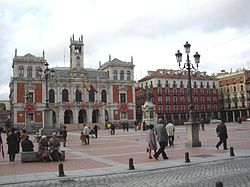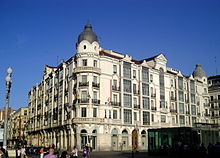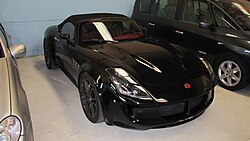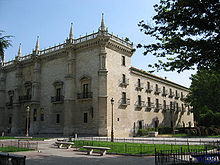Valladolid: Difference between revisions
No edit summary |
|||
| Line 266: | Line 266: | ||
|author=ÍÑIGO SALINAS |
|author=ÍÑIGO SALINAS |
||
|accessdate=2011-11-10}}</ref> |
|accessdate=2011-11-10}}</ref> |
||
The [[Campo Grande (Valladolid)|Campo Grande]], a large public park located in the heart of the city, dates back to 1787. |
|||
The [[National Sculpture Museum]] is site in [[San Gregorio College]], a Flemish Gothic style building. It is home to polychrome carvings made by artists like [[Alonso Berruguete]] or [[Gregorio Fernández]]. The Museum of Contemporary Spanish Art, located in the Patio Herreriano, one of the cloisters of the former Monastery of San Benito, preserves more than 800 paintings and sculptures from the 20th century. |
The [[National Sculpture Museum]] is site in [[San Gregorio College]], a Flemish Gothic style building. It is home to polychrome carvings made by artists like [[Alonso Berruguete]] or [[Gregorio Fernández]]. The Museum of Contemporary Spanish Art, located in the Patio Herreriano, one of the cloisters of the former Monastery of San Benito, preserves more than 800 paintings and sculptures from the 20th century. |
||
Revision as of 11:45, 5 June 2013
This article needs additional citations for verification. (June 2010) |
Valladolid | |
|---|---|
 | |
| Country | |
| Autonomous community | |
| Province | Valladolid |
| Comarca | Campiña del Pisuerga |
| Judicial district | Valladolid |
| Founded | 1072 |
| Government | |
| • Alcalde | Francisco Javier León de la Riva (2007) (PP) |
| Area | |
| • Municipality | 197.91 km2 (76.41 sq mi) |
| Elevation | 698 m (2,290 ft) |
| Population (2011) | |
| • Municipality | 311,501 |
| • Density | 1,600/km2 (4,100/sq mi) |
| • Metro | 416,756 |
| Demonym(s) | Vallisoletano, -a (unformally, pucelano, -a) |
| Time zone | UTC+1 (CET) |
| • Summer (DST) | UTC+2 (CEST) |
| Postal code | 47001 – 47016 |
| Dialing code | 983 |
| Official language(s) | Spanish |
| Website | Official website |
Valladolid (Spanish pronunciation: [baʎaðoˈlið]) is the capital city of the autonomous region of Castile and León and the Province of Valladolid in north-western Spain. It is situated at the confluence of the Pisuerga and Esgueva rivers, and located within three winegrowing regions: Ribera del Duero, Rueda and Cigales. It has a population of 311,501 people, making it Spain's 13th most populous municipality and northwestern Spain's biggest city.[1] Its metropolitan area ranks 20th in Spain with a population of 413,605 people in 23 municipalities (INE 2011).
Valladolid was originally settled in pre-Roman times by the Celtic Vaccaei people, and later the Romans themselves. It remained a small settlement until being re-established by King Alfonso VI of Castile as a Lordship for the Count Pedro Ansúrez in 1072. It grew to prominence in the Middle Ages as the seat of the Court of Castile and being endowed with fairs and different institutions as a collegiate church, University, Royal Court and Chancery and the Casa de la Moneda[disambiguation needed]. The Catholic Monarchs, Isabel I of Castile and Ferdinand II of Aragon, married in Valladolid in 1469 and established it as the capital of the Kingdom of Castile and later of united Spain. Christopher Columbus died in Valladolid in 1506, while authors Francisco de Quevedo and Miguel de Cervantes lived and worked in the city. It was also a cultural centre in the Spanish Renaissance, although a fire in 1561 forced Phillip II to move the capital to Madrid. It briefly returned to Valladolid under Phillip III between 1601 and 1606, before returning indefinitely to Madrid. The city then declined until the arrival of the railroad in the 19th century, and with its industrialisation, already in the 20th century.
Valladolid's Old Town preserves a set composed of historic houses, palaces, churches, plazas, avenues and parks, along with a heritage museum which features the National Museum of Sculpture, the Museum of Contemporary Art Patio Herreriano or the Oriental Museum, as well as the museum houses of José Zorrilla and Cervantes. Among the events that are held each year in the city include the Holy Week in Valladolid, the Valladolid International Film Week (Seminci), or the Theatre Festival and street arts (TAC).
Etymology

One popular etymology suggests that the modern name "Valladolid" derives from a Celtiberian language expression, Vallis Tolitum ("Waters Valley"), referring to the confluence of rivers in the valley. Another suggests that the modern name derives from the Arabic expression "Ballad Al-Waleed" بلد الوليد, which means the city of "Al-Waleed", referring to "Al-Waleed Ibn Abd El-Malek" who ruled the Islamic Empire between (668-715) which included "Valladolid".
The generally accepted derivation is from the demonym Vallisoletano, which was, in fact, the Spanish demonym of the city, and means "from sunny valley". Supporting this are texts from the Middle Ages, which use Vallisoletum, a word that continued to be used as late as the 16th century (see painting by Braun and Hogenberg).
It is also popularly called Pucela, a nickname whose origin is not clear, but probably refers to a few knights who accompanied Joan of Arc, known as La Pucelle. Another theory is that Pucela comes from the fact that Puzzeli's cement was sold there, the only city in Spain that sold it.
History


Remains of Celtiberian and of a Roman camp have been excavated near the city. The nucleus of the city was originally located in the area of the current San Miguel y el Rosarillo square, and was surrounded by a palisade. Archaeological proofs of the existence of three ancient lines of walls have been found.
During the time of Moorish rule in Spain the Christian kings moved the population of this region north into more easily defended areas, and deliberately created a no man's land as a buffer zone against further Moorish conquests. The area was captured from the Moors in the 10th century, and Valladolid was a village until King Alfonso VI of León and Castile donated it to Count Pedro Ansúrez in 1072. He built a palace (now lost) for himself and his wife, Countess Eylo, the Collegiate of St. Mary and the La Antigua churches. In the 12th and 13th centuries, Valladolid grew rapidly, thanks also to the commercial privileges granted by the kings Alfonso VIII and Alfonso X, as well as to the repopulation of the area after the Reconquista.
In 1469 Queen Isabella I of Castile and King Ferdinand of Aragon were married in the city; by the 15th century Valladolid was the residence of the kings of Castile and remained the capital of the Kingdom of Spain until 1561, when the city was destroyed by a fire and Philip II, born here, moved the capital to Madrid, starting a period of decadence for Valladolid. In 1506 Christopher Columbus died in Valladolid in a house that is now a Museum dedicated to him. It was made the capital of the kingdom again between 1601 and 1606 by Philip III. The city was again damaged by a flood of the rivers Pisuerga and Esgueva.





Despite the damage to the old city by the 1960s economic boom, it still boasts a few architectural manifestations of its former glory. Some monuments include the unfinished cathedral, the Plaza Mayor (Main Square), which was the model for that of Madrid, and of other main squares throughout the former Spanish Empire, the National Sculpture Museum, next to the church of Saint Paul, which includes Spain's greatest collections of polychrome wood sculptures, and the Faculty of Law of the University of Valladolid, whose façade is one of the few surviving works by Narciso Tomei, the same artist who did the transparente in Toledo Cathedral. The Science Museum is next to the river Pisuerga. The only surviving house of Miguel de Cervantes is also located in Valladolid. Although unfinished, the Cathedral of Valladolid was designed by Juan de Herrera, architect of El Escorial.
Climate
Valladolid has a warm summer Mediterranean climate (Csb) in the Köppen climate classification.
| Climate data for Valladolid | |||||||||||||
|---|---|---|---|---|---|---|---|---|---|---|---|---|---|
| Month | Jan | Feb | Mar | Apr | May | Jun | Jul | Aug | Sep | Oct | Nov | Dec | Year |
| Record high °C (°F) | 17.0 (62.6) |
23.6 (74.5) |
24.6 (76.3) |
29.2 (84.6) |
33.0 (91.4) |
37.0 (98.6) |
39.4 (102.9) |
38.6 (101.5) |
37.6 (99.7) |
29.0 (84.2) |
23.2 (73.8) |
19.8 (67.6) |
39.4 (102.9) |
| Mean daily maximum °C (°F) | 7.4 (45.3) |
10.3 (50.5) |
13.4 (56.1) |
14.8 (58.6) |
18.7 (65.7) |
23.9 (75.0) |
28.5 (83.3) |
28.2 (82.8) |
24.2 (75.6) |
17.6 (63.7) |
11.8 (53.2) |
8.1 (46.6) |
17.2 (63.0) |
| Daily mean °C (°F) | 3.1 (37.6) |
5.1 (41.2) |
7.2 (45.0) |
8.7 (47.7) |
12.3 (54.1) |
16.6 (61.9) |
20.1 (68.2) |
20.1 (68.2) |
17.0 (62.6) |
11.8 (53.2) |
6.9 (44.4) |
4.2 (39.6) |
11.1 (52.0) |
| Mean daily minimum °C (°F) | −1.2 (29.8) |
−0.1 (31.8) |
1.0 (33.8) |
2.6 (36.7) |
5.8 (42.4) |
9.2 (48.6) |
11.7 (53.1) |
12.0 (53.6) |
9.8 (49.6) |
6.0 (42.8) |
2.1 (35.8) |
0.2 (32.4) |
4.9 (40.8) |
| Record low °C (°F) | −18.8 (−1.8) |
−16 (3) |
−12.4 (9.7) |
−6.5 (20.3) |
−5.4 (22.3) |
−0.5 (31.1) |
2.4 (36.3) |
2.4 (36.3) |
−0.4 (31.3) |
−5.6 (21.9) |
−9.2 (15.4) |
−12.6 (9.3) |
−18.8 (−1.8) |
| Average precipitation mm (inches) | 42 (1.7) |
33 (1.3) |
23 (0.9) |
48 (1.9) |
54 (2.1) |
35 (1.4) |
19 (0.7) |
19 (0.7) |
30 (1.2) |
45 (1.8) |
48 (1.9) |
55 (2.2) |
455 (17.9) |
| Average precipitation days (≥ 1.0 mm) | 7 | 6 | 5 | 8 | 9 | 5 | 3 | 3 | 4 | 7 | 7 | 8 | 71 |
| Average relative humidity (%) | 86 | 76 | 66 | 66 | 65 | 58 | 49 | 51 | 58 | 72 | 81 | 87 | 68 |
| Mean monthly sunshine hours | 120 | 155 | 203 | 220 | 264 | 313 | 361 | 340 | 245 | 196 | 136 | 98 | 2,645 |
| Source 1: Agencia Estatal de Meteorología (normals 1971–2000) [2] | |||||||||||||
| Source 2: Agencia Estatal de Meteorología (extremes only 1938–2012) [3] | |||||||||||||
Main sights
The capital of Castile y León preserves in its old quarter heritage of aristocratic houses and religious buildings.
Interesting religious buildings
- The unfinished Cathedral, commissioned by King Philip II and designed by the architect Juan de Herrera in the 16th century, following a Mannerist style perhaps influenced by Michelangelo. The church is unfinished owing to financial problems and its nave was not opened until 1668. Years later, in 1730, Master Churriguera finished the work on the main front. Inside the cathedral, the sanctuary houses a reredos made by Juan de Juni in 1562. The complex is linked to the Diocesan Museum, which holds carvings attributed to Gregorio Fernández and Juni himself, as well as a silver monstrance by Juan de Arce.
- The large Gothic church of San Benito, built by the Benedictines between 1500 and 1515, with an unusual tower.
- San Miguel Church, ancient church of the Jesuits (now, parish church), built at the end of the 16th century, hosts some reredos by the early 17th-century sculptor Gregorio Fernández.
- The façade of the Dominican Church of San Pablo, characterized by Gothic statues and decoration built around 1500.
- El Salvador Church, with a façade built around 1550, a 15th-century Flemish reredos and a brick tower dating from the 17th century.
- The church of Santiago has reredos depicting the Adoration of the Magi (1537) created by Berruguete and, in the sanctuary, a great Baroque reredos depicting Saint James killing Moors, as usual in Spain.
- The Gothic church of Santa María la Antigua has an unusual pyramid-shaped Romanesque tower from the 12th century and a 14th-century Gothic sanctuary, influenced by the Cathedral of Burgos.
- The Convent of Santa María la Real de las Huelgas, originally built about 1600, following Spanish Mannerist tendencies.
- Convento de Santa Ana, a Neoclassical building housing various paintings by Francisco de Goya.
- San Juan de Letrán Church, featuring a Baroque façade built in 1737. Beside this last church is the Monasterio de los Padres Filipinos, designed by the architect Ventura Rodríguez in 1760.
Other buildings



The heart of the old city is the 16th-century Plaza Mayor, presided over by a statue of Count Ansúrez from 1903. On one side of it stands the City Hall, an eclectic building dating from the beginning of the 20th century, crowned by a clock tower. In the nearby streets is the Palace of Los Pimentel, today the seat of the Provincial Council. It is one of the most important palaces, as King Philip II was born here on 21 May 1527. The Royal Palace (where King Philip IV of Spain and Queen Anne of France, mother of Louis XIV were born), the 16th-century Palace of the Marquises of Valverde, and that of the banker Fabio Nelli – a building with a Classicist stamp built in 1576 – should also be pointed out. The Museum of Valladolid occupies this complex, exhibiting a collection of furniture, sculptures, paintings and ceramic pieces dated from Prehistoric times to the present.
The Teatro Lope de Vega is a theater built in the classical style in 1861 and now very run-down. There has been controversy over whether the city should pay to restore it.[4]
The Campo Grande, a large public park located in the heart of the city, dates back to 1787.
The National Sculpture Museum is site in San Gregorio College, a Flemish Gothic style building. It is home to polychrome carvings made by artists like Alonso Berruguete or Gregorio Fernández. The Museum of Contemporary Spanish Art, located in the Patio Herreriano, one of the cloisters of the former Monastery of San Benito, preserves more than 800 paintings and sculptures from the 20th century.
The University, whose Baroque façade is decorated with various academic symbols, and the Santa Cruz College, which as well as housing a library forms one of the first examples of the Spanish Renaissance.
The city preserves houses where great historical characters once lived. They include:
- the Casa de Cervantes, where the author of Don Quijote lived with his family between 1603 and 1606. It was in this house where the writer finished his masterpiece.
- The Christopher Columbus House-Museum is located in the what is thought to be the residence of the Genoese navigator in the last years of his life. Nowadays the palace exhibits various pieces and documents related to the discovery of America.
- The house where José Zorrilla was born, housing various personal possessions, furniture and documents that belonged to the Romantic writer.


Population
As of the 2004 census, the population of the city of Valladolid proper was 321,713, and the population of the entire urban area was estimated to be near 420,000. After the new neighbourhoods developed in recent decades (one example would be Covaresa) the high prices in the municipality led young people to buy properties in towns around the city, so the population has tended to fall in Valladolid but is growing fast in the rest of the urban area (for example, Arroyo de la Encomienda or Zaratán)
Economy

Valladolid is, economically speaking, the most important city of the autonomous community, having an important automobile industry (IVECO, FASA-Renault, Michelin).
Transportation
There is an airport at nearby Villanubla (10 km from Valladolid city centre), with connections to Barcelona, Málaga, and the Canary Islands.
Seminci

The city is also host to one of the foremost (and oldest) international film festivals, the Semana Internacional de Cine de Valladolid (Seminci), founded in 1956.
Local cuisine


Although an inland province, fish is commonly consumed, some brought from the Cantabrian Sea. Fish like red bream and hake are a major part of Valladolid's cuisine.
The main speciality of Valladolid is, however, lechazo (suckling baby lamb). The lechazo is slowly roasted in a wood oven and served with salad.
Valladolid also offers a great assortment of wild mushrooms. Asparagus, endive and beans can also be found. Some legumes, like white beans and lentils are particularly good. Pine nuts are also produced in great quantities.
Sheep cheese from Villalón de Campos, the famous pata de mulo (mule's leg) is usually unripened (fresh), but if it is cured the ripening process brings out such flavour that it can compete with the best sheep cheeses in Spain.
In the area of bread Valladolid has a bread to go with every dish, like the delicious cuadros from Medina del Campo, the muffins, the pork-scratching bread and the lechuguinos, with a pattern of concentric circles that resemble a head of lettuce.
The pastries and baked goods from the province of Valladolid are well-known, specially St. Mary's ring-shaped pastries, St. Claire's sponge cakes, pine nut balls and cream fritters.
Valladolid is also a producer of wines. The ones that fall under the Designation of Origin Cigales are very good. White wines from Rueda and red wines from Ribera del Duero are known for their quality.
Easter



Holy Week holds ("Semana Santa" in Spanish) one of the best known Catholic traditions in Valladolid. The Good Friday processions are considered an exquisite and rich display of Castilian religious sculpture. On this day, in the morning, members of the brotherhoods on horseback make a poetic proclamation throughout the city. The "Sermon of the Seven Words" is spoken in Plaza Mayor Square. In the afternoon, thousands of people take part in the Passion Procession, comprising 31 pasos (religious statues), most of which date from the 16th and 17th centuries. The last statue in the procession is the Virgen de las Angustias, and her return to the church is one of the most emotional moments of the celebrations, with the Salve Popular sung in her honour.
Easter is one of the most spectacular and emotional fiestas here. Religious devotion, art, colour and music combine in acts to commemorate the death of Jesus Christ: the processions. Members of the different Easter brotherhoods, dressed in their characteristic robes, parade through the streets carrying religious statues (pasos) to the sound of drums and music – scenes of sober beauty.
Sport
Valladolid's main association football club is Real Valladolid, nickanemed Pucela, who play in the country's highest league, the Primera División. Players who went on to play for the Spain national football team include Fernando Hierro, José Luis Caminero and Rubén Baraja.
CB Valladolid is the city's basketball team and they play in the Liga ACB. Arvydas Sabonis played in this team. The matches are held in the Polideportivo Pisuerga.
In handball Valladolid is represented by BM Valladolid of the Liga ASOBAL. They have won 2 King's Cup, 1 ASOBAL Cup and 1 EHF Cup. They play their games in the Polideportivo Huerta del Rey.
CR El Salvador, current champions of Spain's División de Honor de Rugby compete in the European Challenge Cup. They play their matches at Estadio Pepe Rojo. VRAC, current champions of the King's Cup, also plays in the same stadium.
Twin towns – sister cities

Friendship cities
 Ahmedabad, India
Ahmedabad, India Boston, United States
Boston, United States Guadalajara, Mexico
Guadalajara, Mexico
See also
References
- ^ "Instituto nacional de Estadística, Padrón 2012". Retrieved 26 September 2012.
{{cite web}}: Unknown parameter|deadurl=ignored (|url-status=suggested) (help) Population figures from 1 January 2011. - ^ "Valores climatológicos normales. Valladolid Aeropuerto" (in Spanish). Agencia Estatal de Meteorología. Retrieved 22 September 2012.
- ^ "Valores extremos. Valladolid Aeropuerto" (in Spanish). Agencia Estatal de Meteorología. Retrieved 22 September 2012.
- ^ ÍÑIGO SALINAS (2008-08-27). "De la Riva confía en que las obras del Lope de Vega salgan adelante". El Norte de Castille (in Spanish). Retrieved 2011-11-10.
External links
Institutions
- Ayuntamiento de Valladolid
- Valladolid's Library
- Culture Foundation
- Tourism in Valladolid province
- City Hall of Valladolid
- University of Valladolid
- Miguel de Cervantes European University
- Fair of Valladolid
- Congress Center of Valladolid
Museums
- Museo de la Ciencia
- Museo Nacional de Escultura
- Museo Casa Cervantes
- Museo Casa de Cristóbal Colón
- Cristóbal Gabarrón Foundation
- Museo Casa de Zorrilla
- Oriental
- Patio Herreriano



